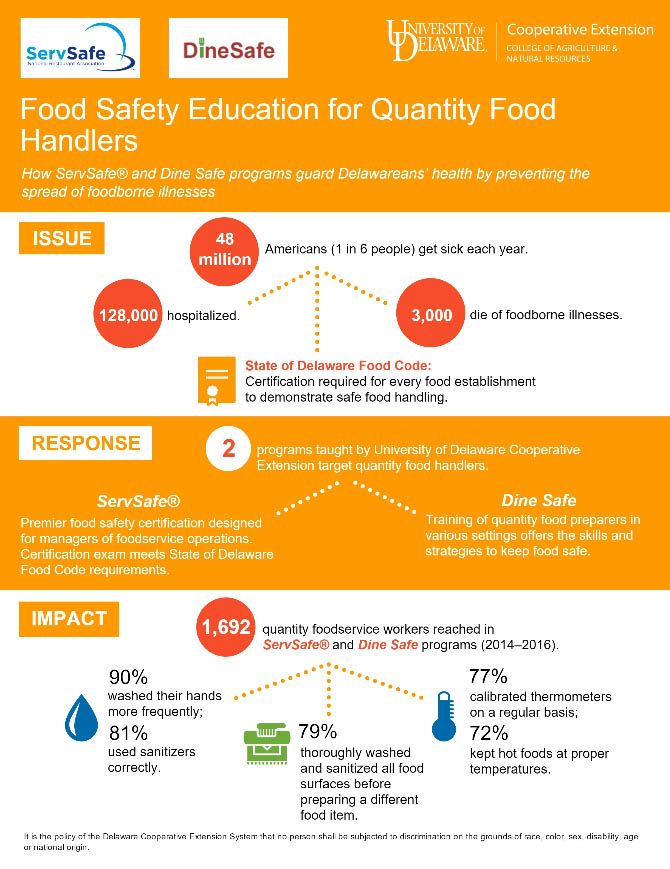
Food Safety Education for Quantity Food Handlers (2016)
- Health & Well-being
-
Agricultural Programs
- Agribusiness
- Animal Science
- Beginning Farmer Program
- Commercial Crops
- Commericial Horticulture
- Delaware Soil Testing Program
- Disease Management
- Farm Vitality and Health Project
- Irrigation
- Nutrient Management
-
Insect Pest Management
- Insect Trapping Program
- IPM Hot Topics
- Commercial Field Crop Insect Management
- Commercial Field Crop Disease Management
- Commercial Fruit & Vegetable Crop Pest Management
- EIPM Implementation Projects
- Pollinators
- Research and Extension Demonstration Results
- Brown Marmorated Stink Bug (BMSB) Management, Research, and Resources
- Publications
- Pesticide Safety Education Program
- UD Plant Diagnostic Clinic
- Variety Trials
- Weed Science
- Certified Crop Advisor Program
- Poultry Biosecurity
- 4-H
-
Horticulture
- Climate Variability and Change
- Delaware Soil Testing Program
- Forestry
- Lawn and Garden
- Master Gardeners
- Master Naturalist Program
-
Nutrient Management
- Nutrient Management Certification
- Continuing Education for Nutrient Management
- Nutrient Management Planning Resources
- Commercial Nutrient Handler Resources
- Poultry Litter and Manure Management
- Turf Management
- Agriculture Notebook
- Horticulture Handbook
- Agriculture & Horticulture Handbooks
- Crop Production
- Soil Fertility
- Delaware Climate Change Coordination Initiative (DECCCI)
- Salt Impacted Agricultural Lands

ISSUE
Foodborne illnesses are a common and costly—yet preventable—public health issue. According to the Centers for Disease Control and Prevention, approximately 1 in 6 Americans (approximately 48 million people) get sick, 128,000 are hospitalized and 3,000 die of foodborne illnesses each year. Estimates are used because only a fraction of illnesses are actually diagnosed and reported. As result, Delaware now requires every permitted food establishment to designate a person in charge who can demonstrate knowledge of safe food handling by passing a certification exam.
RESPONSE
University of Delaware (UD) Cooperative Extension has two programs that target quantity food handlers. Designed for managers of foodservice operations, the ServSafe® program is the premier food safety certification offered by the National Restaurant Association Educational Foundation. Successful completion of the certification exam helps in meeting the State of Delaware Food Code requirements. Dine Safe trains quantity food preparers working in a variety of settings. They learn skills and strategies required to keep food safe regardless of their specific jobs. ServSafe® and Dine Safe participants work in retail operations, school foodservice, church kitchens, childcare settings as well as restaurants.
IMPACT
During the past three years (2014–2016), UD Cooperative Extension reached 1,692 quantity foodservice workers in the ServSafe® and Dine Safe programs. After successful completion of trainings, attendees personally carried out or instructed their staffs to execute the following:
- 90% washed their hands more frequently
- 77% calibrated thermometers on a regular basis
- 72% kept hot foods at or above 135 °F
- 81% used sanitizers correctly, including checking for proper concentration
- 79% thoroughly washed and sanitized all food surfaces before preparing a different food item
The University of Delaware is an Equal Opportunity Institution and Provider. Visit UD’s Office of Equity & Inclusion to learn more.
Additional Links
531 South College Avenue Newark, DE 19716 (302) 831-2501
